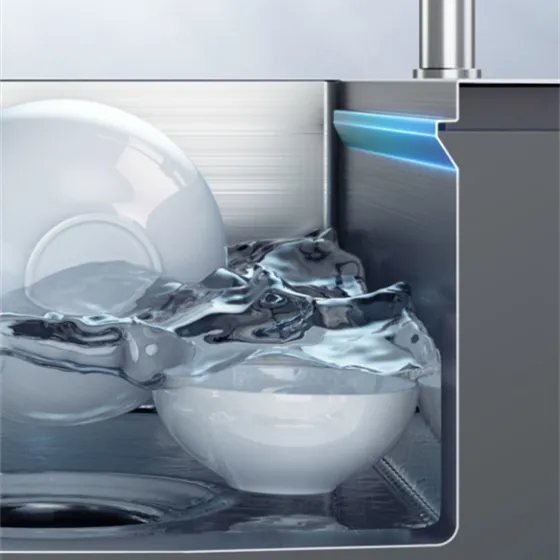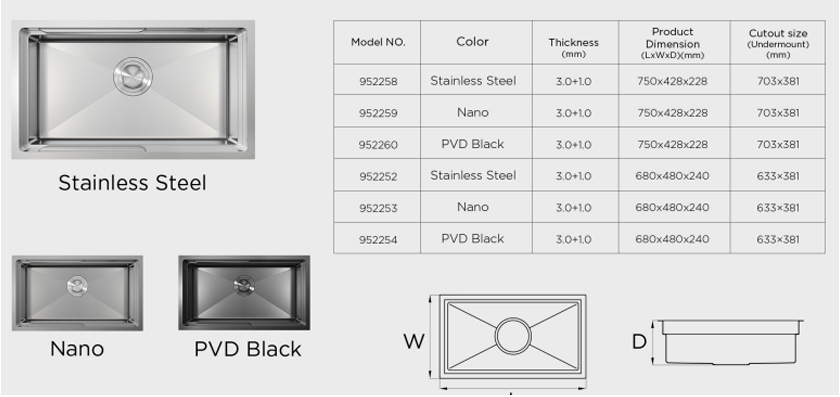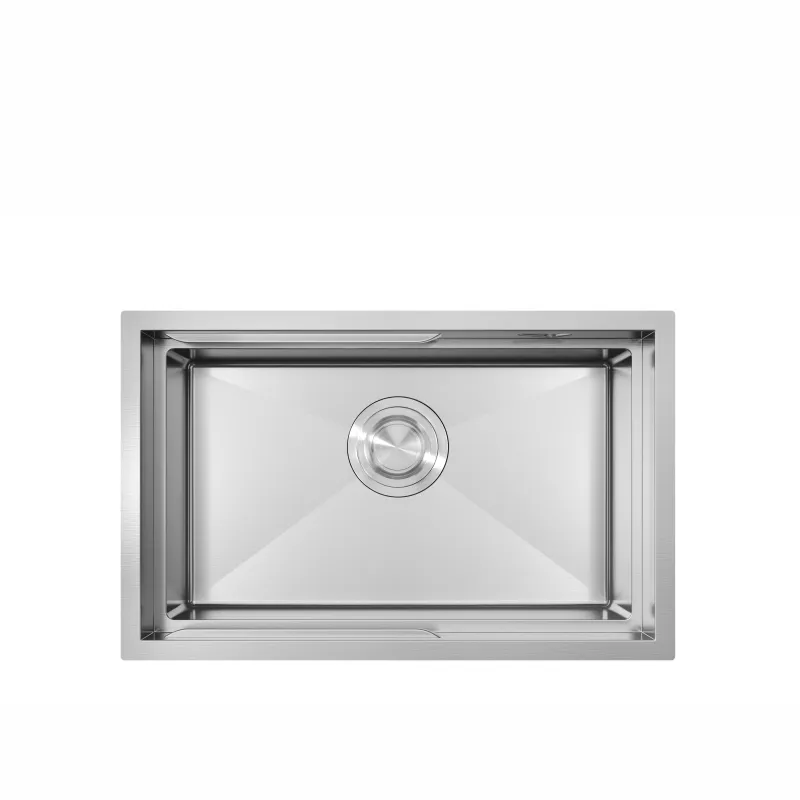Undermount kitchen sinks are a mainstream choice in kitchen renovations.
Compared to traditional countertop basins, undermount designs are not only simpler and more aesthetically pleasing, but also make cleaning countertop food residue much easier. However, many people often ask a crucial question when purchasing or installing one: "How deep should an undermount kitchen sink be?"
This seemingly simple question actually involves multiple aspects, including user comfort, ergonomics, drainage efficiency, and countertop structure.
This article will take a professional perspective, providing an in-depth analysis of the standard depth of kitchen undermount sinks, influencing factors, selection suggestions, and reasonable depth ranges for different needs, helping you find the ideal sink size.

Why is the depth of an undermount kitchen sink so important?
Among all kitchen accessories, the depth of an undermount kitchen sink determines the comfort and practicality of the user experience.
If the sink is too shallow, water will easily splash when washing large pots and pans; if it is too deep, it will cause excessive bending of the back, leading to fatigue over long-term use.
Sink depth affects not only cleaning efficiency but also several other key factors:
1). Usage Posture and Human Comfort
The depth of the sink directly determines the angle of your arms when washing. If the depth exceeds the optimal working range for the human body, it can cause pressure on the shoulders, neck, and lower back.
2). Drainage Performance
An undermount sink that is too shallow may have insufficient drainage speed, while an overly deep sink may increase the bends in the drain pipes, affecting flow rate.
3). Installation and Countertop Structure Limitations
Undermount installation means the edge of the sink is below the countertop. If the depth is too great, it will affect the space in the cabinets below, especially for installing trash cans or water purifiers.
4). Visual and Operational Experience
A sink that is too deep can obstruct the view inside, making it difficult to wash small dishes or food.
Therefore, choosing the right depth is not only about appearance but also about long-term comfort and practical efficiency.
What is the standard depth for an undermount kitchen sink?
In actual design and installation, the standard depth of kitchen undermount sinks is typically between 18 cm and 25 cm (approximately 7 to 10 inches).
However, this is only a general reference range. The specific choice should be made in conjunction with the kitchen countertop height and the user's height.
The following are the characteristics of different depth ranges:
Water tank depth | Features | Target Audience and Scenarios |
| 16-18cm (approx. 6-7 inches) | Shallow depth, easy to clean but prone to splashing | Shorter users with limited kitchen space |
| 19-21cm (approx. 7.5-8 inches) | Balanced design, suitable for everyday household use | A standard choice for ordinary families |
| 22-25cm (approx. 8.5-10 inches) | Large capacity, suitable for washing large pots and pans | Families that cook frequently and have large tableware |
| >25cm | Excessive depth may affect comfort | Only suitable for special customization needs |
Therefore, a depth of 19-22 cm is usually the ideal choice for most kitchen undermount sinks, balancing washing space and user comfort.

How to determine the depth of an undermount kitchen sink based on ergonomics?
When choosing the appropriate sink depth, ergonomics should be the core principle.
Because the actual usable height of the sink = (countertop height - sink depth - installation sinking distance).
If these factors are ignored, even if a seemingly standard sink is chosen, the problem of "uncomfortable use" may occur.
1. Ideal Working Height
Ergonomic studies show that the ideal washing height should be slightly lower than the user's elbow, approximately 10-15 cm.
This means:
• If your height is 160cm, the suitable sink operating height is approximately 85cm;
• If your height is 175cm, the suitable operating height is approximately 90cm.
Assuming the kitchen countertop height is fixed at 90cm, the following formula can be used to calculate:
(Tank depth + sinking distance) ≈ (Countertop height - Ideal operating height)
Example:
If your ideal operating height is 80cm and the countertop height is 90cm, then the total recessed depth should be approximately 10cm.
If the undermount kitchen sink is 20cm deep and the recessed distance during installation is 2cm, then the operating surface will be approximately 68cm, which is too low and may require adjustment.
Therefore, the sink depth needs to be considered in conjunction with the user's height and countertop thickness to achieve the most comfortable operating posture.

Why shouldn't kitchen undermount sinks be too deep?
While deeper sinks may seem to hold more dishes, excessive depth can lead to several inconveniences:
1. Uncomfortable Use
Frequent bending over while washing dishes can cause back pain and increase fatigue over time.
2. Water Pressure and Splashing Issues
The greater drop in water flow in a deep sink can cause backflow, especially with high-pressure kitchen faucets.
3. Limited Lighting and Visibility
Deep sinks tend to be darker, limiting visibility when washing small dishes or using strainers.
4. Reduced Undermount Space
Undermount kitchen sinks already occupy space in the lower cabinets; excessive depth can affect storage and the installation of water purifiers.
5. Increased Cleaning Difficulty
Deeper corners are harder to clean, especially in square or right-angled sinks, which are prone to limescale buildup.
Therefore, striking a balance between practicality and capacity is key.
What is the Recommended Depth for an Undermount Kitchen Sink for Different Kitchen Needs?
Different cooking habits, kitchen layouts, and heights all influence the ideal sink depth. Here are some suggestions for reference:
Usage Scenarios | Recommended depth | Description |
| Daily Family Kitchen | 19~22cm | Balanced design for comfortable washing and moderate capacity |
Frequent cooking, large tableware | 22~25cm | Easier to place pots and pans and wash fruits and vegetables |
| Short stature (<160cm) | 17~19cm | Reduces bending over strain |
| Tall stature (>175cm) | 21~23cm | Allows more space while maintaining comfortable operation |
| Small Apartment Kitchen | 17~20cm | Minimizes under-counter space usage, facilitating the installation of water purification systems |
| Double Sink | 18~21cm | Maintains a balance between capacity and zoning |
As you can see, 19-22 cm is the most universal and comfortable depth range, balancing ergonomics with ease of use.
Does the installation method of an undermount kitchen sink affect the perceived depth?
The answer is yes. The installation method directly affects the "actual depth" during use.
1. Undermount Installation
The edge of the sink is below the countertop, which is typically 2-3 cm thick. This means the sink appears "deeper" to the user, creating a slightly sunken feel both visually and operationally.
2. Flush Mount Installation
The edge of the sink is flush with the countertop, resulting in a relatively neutral sense of depth. Suitable for kitchens where a completely flat countertop is required.
3. Sink Reveal Installation
If the sink is sunken too much (>2cm), it increases the actual working depth; if it's close to the countertop, it appears shallower during use.
Therefore, when choosing the depth of a sink, the installation method must also be considered; otherwise, a discrepancy between the expected and actual depth will occur.

Does the depth of an undermount kitchen sink depend on its material and shape?
Yes. While "depth" primarily depends on the design dimensions, the material and shape also indirectly affect the user experience.
1. Stainless Steel Undermount Kitchen Sinks
Because stainless steel is relatively thin (typically 0.8~1.2mm), its internal space is slightly larger for the same external dimensions. Therefore, a 20cm deep stainless steel sink feels more "deep."
2. Quartz or Composite Stone Sinks
Thicker materials reduce the effective internal depth. For example, a composite stone sink labeled as 20cm deep may only have about 18cm of usable space.
3. Square Sinks vs. Rounded Corner Sinks
Square designs have a flatter bottom, accommodating more dishes; rounded corner designs are easier to clean but slightly reduce the perceived volume.
4. Differences between Single and Double Bowl Sinks
Double bowl designs typically have slightly shallower depths in each bowl to maintain overall height balance; single bowls can be deeper to increase capacity.
Therefore, when choosing a sink, consider material thickness, shape, and partition structure to ensure the actual usable depth matches your expectations.
How to Measure and Verify the Proper Depth of an Undermount Kitchen Sink?
To ensure your purchased kitchen undermount sink meets your needs, you can measure using the following steps:
• Measure the usable height: The distance from the floor to the top of the countertop.
• Calculate the ideal depth: Determine your ideal operating height based on your height (10-15cm below the elbow), and subtract this value from the countertop height.
• Consider the sink's recessed distance: Undermount installations typically recess 2-3cm; add this value to obtain the maximum usable depth.
• Verify the internal height: When choosing a sink, check the "internal depth" rather than the "external dimensions" to ensure the actual space meets your needs.
• Simulate use: Before purchasing, simulate the sink depth using a cardboard box and observe whether the arm bending angle is comfortable.
This measurement method avoids the embarrassment of finding the sink too deep or too shallow after purchase.
What is the ideal depth for an undermount kitchen sink?
Based on the above analysis, we can draw the following conclusions:
• Standard depth range: 18cm~25cm;
• Recommended optimal depth: 19~22cm;
• Influencing factors: Human height, countertop height, installation method, material thickness, and under-cabinet space;
• Principle: Comfort > Capacity.
In short, if your kitchen countertop height is between 85 and 90cm, a 20±1cm deep undermount kitchen sink is ideal.
It can accommodate everyday tableware without increasing user fatigue, making it the golden depth choice for most families.
Can small businesses also buy from Higold, or only large distributors?
While Higold is known for large-scale wholesale supply, we also support smaller buyers with flexible purchasing options. Whether you are a retailer, distributor, or brand developer, you can buy directly from our factory at competitive prices. We provide ODM solutions, sample availability, and promotional discounts, making our products accessible to businesses of all sizes worldwide.


